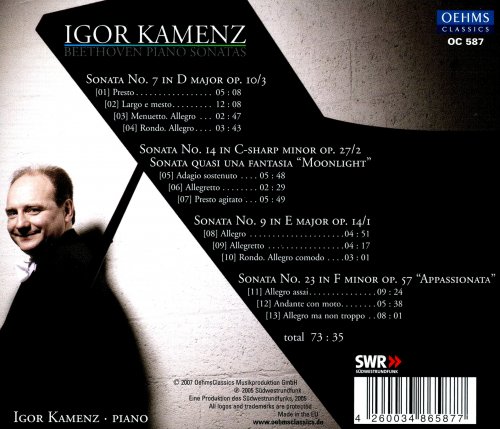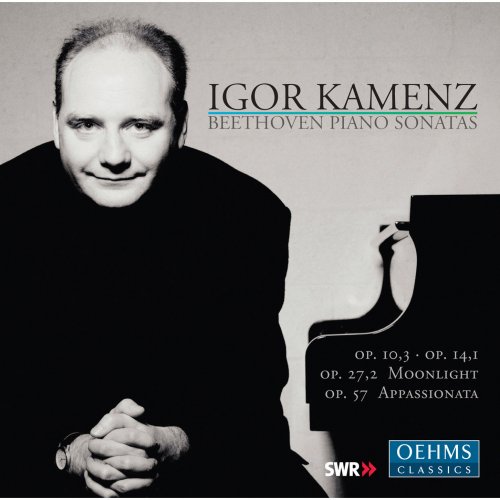
Igor Kamenz - Beethoven: Piano Sonatas Nos. 7, 9, 14 "Moonlight" & 23 "Appassionata" (2016)
BAND/ARTIST: Igor Kamenz
- Title: Beethoven: Piano Sonatas Nos. 7, 9, 14 "Moonlight" & 23 "Appassionata"
- Year Of Release: 2016
- Label: Oehms Classics
- Genre: Classical Piano
- Quality: flac lossless
- Total Time: 01:13:09
- Total Size: 202 mb
- WebSite: Album Preview
Tracklist
01. Piano Sonata No. 7 in D Major, Op. 10 No. 3: I. Presto
02. Piano Sonata No. 7 in D Major, Op. 10 No. 3: II. Largo e mesto
03. Piano Sonata No. 7 in D Major, Op. 10 No. 3: III. Menuetto. Allegro
04. Piano Sonata No. 7 in D Major, Op. 10 No. 3: IV. Rondo. Allegro
05. Piano Sonata No. 14 in C - Sharp Minor, Op. 27 No. 2 "Moonlight": I. Adagio sostenuto
06. Piano Sonata No. 14 in C - Sharp Minor, Op. 27 No. 2 "Moonlight": II. Allegretto
07. Piano Sonata No. 14 in C - Sharp Minor, Op. 27 No. 2 "Moonlight": III. Presto agitato
08. Piano Sonata No. 9 in E Major, Op. 14 No. 1: I. Allegro
09. Piano Sonata No. 9 in E Major, Op. 14 No. 1: II. Allegretto
10. Piano Sonata No. 9 in E Major, Op. 14 No. 1: III. Rondo. Allegro comodo
11. Piano Sonata No. 23 in F Minor, Op. 57 "Appassionata": I. Allegro assai
12. Piano Sonata No. 23 in F Minor, Op. 57 "Appassionata": II. Andante con moto
13. Piano Sonata No. 23 in F Minor, Op. 57 "Appassionata": III. Allegro ma non troppo

The word for the playing of Siberian-born pianist Igor Kamenz is "nuanced." There is certainly no shortage of recordings of the "Moonlight" and "Appassionata" sonatas of Beethoven, but it's understandable that the Oehms label believed that this one would stand out -- it runs counter to current trends that emphasize Beethoven's subjectivity and locate the roots of his radicalism increasingly early in his career. Three of the four sonatas on the disc are from the so-called early period, with the Sonata No. 7 in D major, Op. 10/3, and the Sonata No. 9 in E major, Op. 14/1, as preludes to the two landmarks. Kamenz holds to the traditional view of the early sonatas as fundamentally Classical in orientation. Compared to something like Andras Schiff's deep contrapuntal deconstruction of Op. 10/3, Kamenz's reading is light and often playful. In Op. 14/1, he avoids the usual warm, proto-pastoral reading of the opening material in favor of a more neutral sound, and throughout the program he rarely emphasizes the details one expects. All the music is restrained, but it has plenty of surprises nonetheless. Take the finale of the "Appassionata," where Kamenz downplays the diminshed chords at the beginning - usually these are stark clarions of alarm and panic. Kamenz instead focuses the listener's attention on the passagework that runs through the movement; it seems to flow around and through the movement's basic thematic material, making it restless rather than impassioned. Kamenz has the skills to pick out the individual notes of a vertical sonority for special emphasis, and he is technically impressive in a way that will make this a disc perhaps listened to more by pianists than by general audiences. The latter may find him a bit oversubtle, especially in the "Moonlight," which Beethoven himself designated as fantasy-like. Kamenz goes counter to the trend in the matter of repeats as well; they are routinely omitted. Sampling will go a long way toward informing the listener as to whether he or she will like this quiet, technically impressive, unorthodox performance.
01. Piano Sonata No. 7 in D Major, Op. 10 No. 3: I. Presto
02. Piano Sonata No. 7 in D Major, Op. 10 No. 3: II. Largo e mesto
03. Piano Sonata No. 7 in D Major, Op. 10 No. 3: III. Menuetto. Allegro
04. Piano Sonata No. 7 in D Major, Op. 10 No. 3: IV. Rondo. Allegro
05. Piano Sonata No. 14 in C - Sharp Minor, Op. 27 No. 2 "Moonlight": I. Adagio sostenuto
06. Piano Sonata No. 14 in C - Sharp Minor, Op. 27 No. 2 "Moonlight": II. Allegretto
07. Piano Sonata No. 14 in C - Sharp Minor, Op. 27 No. 2 "Moonlight": III. Presto agitato
08. Piano Sonata No. 9 in E Major, Op. 14 No. 1: I. Allegro
09. Piano Sonata No. 9 in E Major, Op. 14 No. 1: II. Allegretto
10. Piano Sonata No. 9 in E Major, Op. 14 No. 1: III. Rondo. Allegro comodo
11. Piano Sonata No. 23 in F Minor, Op. 57 "Appassionata": I. Allegro assai
12. Piano Sonata No. 23 in F Minor, Op. 57 "Appassionata": II. Andante con moto
13. Piano Sonata No. 23 in F Minor, Op. 57 "Appassionata": III. Allegro ma non troppo

The word for the playing of Siberian-born pianist Igor Kamenz is "nuanced." There is certainly no shortage of recordings of the "Moonlight" and "Appassionata" sonatas of Beethoven, but it's understandable that the Oehms label believed that this one would stand out -- it runs counter to current trends that emphasize Beethoven's subjectivity and locate the roots of his radicalism increasingly early in his career. Three of the four sonatas on the disc are from the so-called early period, with the Sonata No. 7 in D major, Op. 10/3, and the Sonata No. 9 in E major, Op. 14/1, as preludes to the two landmarks. Kamenz holds to the traditional view of the early sonatas as fundamentally Classical in orientation. Compared to something like Andras Schiff's deep contrapuntal deconstruction of Op. 10/3, Kamenz's reading is light and often playful. In Op. 14/1, he avoids the usual warm, proto-pastoral reading of the opening material in favor of a more neutral sound, and throughout the program he rarely emphasizes the details one expects. All the music is restrained, but it has plenty of surprises nonetheless. Take the finale of the "Appassionata," where Kamenz downplays the diminshed chords at the beginning - usually these are stark clarions of alarm and panic. Kamenz instead focuses the listener's attention on the passagework that runs through the movement; it seems to flow around and through the movement's basic thematic material, making it restless rather than impassioned. Kamenz has the skills to pick out the individual notes of a vertical sonority for special emphasis, and he is technically impressive in a way that will make this a disc perhaps listened to more by pianists than by general audiences. The latter may find him a bit oversubtle, especially in the "Moonlight," which Beethoven himself designated as fantasy-like. Kamenz goes counter to the trend in the matter of repeats as well; they are routinely omitted. Sampling will go a long way toward informing the listener as to whether he or she will like this quiet, technically impressive, unorthodox performance.
Year 2016 | Classical | FLAC / APE
As a ISRA.CLOUD's PREMIUM member you will have the following benefits:
- Unlimited high speed downloads
- Download directly without waiting time
- Unlimited parallel downloads
- Support for download accelerators
- No advertising
- Resume broken downloads


